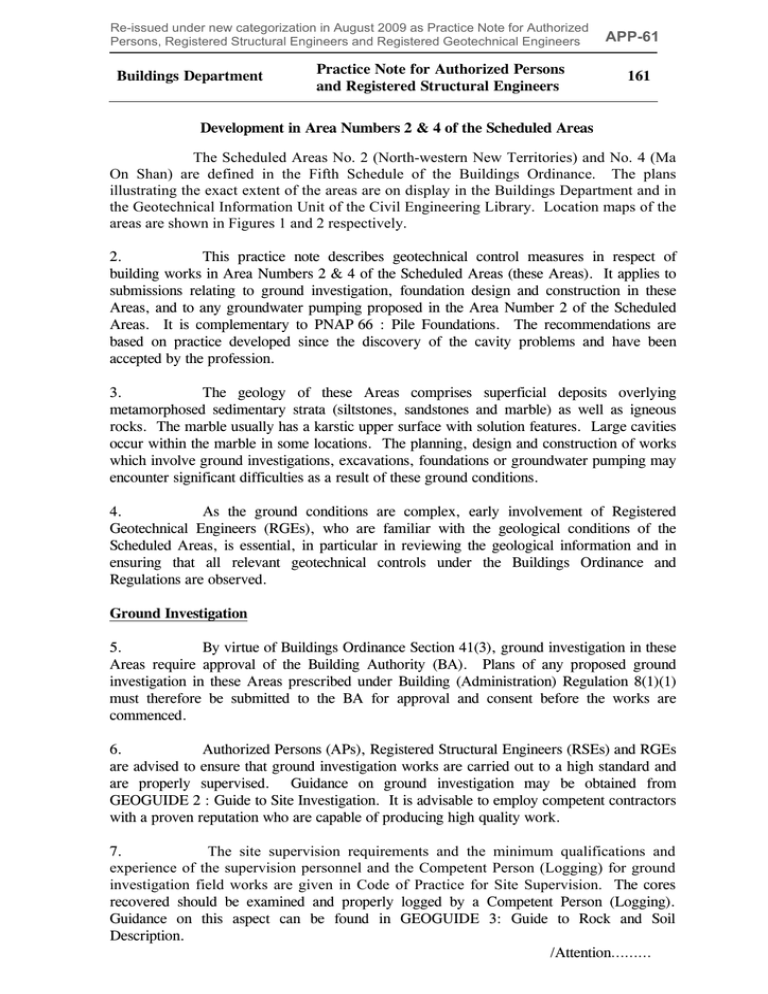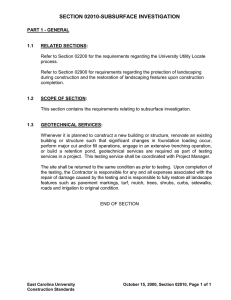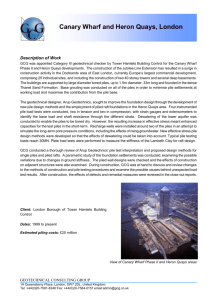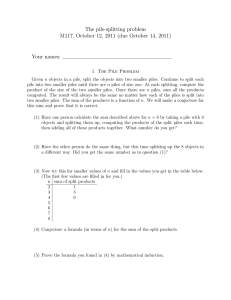Practice Note for Authorized Persons, Registered Structural
advertisement

Re-issued under new categorization in August 2009 as Practice Note for Authorized Persons, Registered Structural Engineers and Registered Geotechnical Engineers Buildings Department Practice Note for Authorized Persons and Registered Structural Engineers APP-61 161 Development in Area Numbers 2 & 4 of the Scheduled Areas The Scheduled Areas No. 2 (North-western New Territories) and No. 4 (Ma On Shan) are defined in the Fifth Schedule of the Buildings Ordinance. The plans illustrating the exact extent of the areas are on display in the Buildings Department and in the Geotechnical Information Unit of the Civil Engineering Library. Location maps of the areas are shown in Figures 1 and 2 respectively. 2. This practice note describes geotechnical control measures in respect of building works in Area Numbers 2 & 4 of the Scheduled Areas (these Areas). It applies to submissions relating to ground investigation, foundation design and construction in these Areas, and to any groundwater pumping proposed in the Area Number 2 of the Scheduled Areas. It is complementary to PNAP 66 : Pile Foundations. The recommendations are based on practice developed since the discovery of the cavity problems and have been accepted by the profession. 3. The geology of these Areas comprises superficial deposits overlying metamorphosed sedimentary strata (siltstones, sandstones and marble) as well as igneous rocks. The marble usually has a karstic upper surface with solution features. Large cavities occur within the marble in some locations. The planning, design and construction of works which involve ground investigations, excavations, foundations or groundwater pumping may encounter significant difficulties as a result of these ground conditions. 4. As the ground conditions are complex, early involvement of Registered Geotechnical Engineers (RGEs), who are familiar with the geological conditions of the Scheduled Areas, is essential, in particular in reviewing the geological information and in ensuring that all relevant geotechnical controls under the Buildings Ordinance and Regulations are observed. Ground Investigation 5. By virtue of Buildings Ordinance Section 41(3), ground investigation in these Areas require approval of the Building Authority (BA). Plans of any proposed ground investigation in these Areas prescribed under Building (Administration) Regulation 8(1)(1) must therefore be submitted to the BA for approval and consent before the works are commenced. 6. Authorized Persons (APs), Registered Structural Engineers (RSEs) and RGEs are advised to ensure that ground investigation works are carried out to a high standard and are properly supervised. Guidance on ground investigation may be obtained from GEOGUIDE 2 : Guide to Site Investigation. It is advisable to employ competent contractors with a proven reputation who are capable of producing high quality work. 7. The site supervision requirements and the minimum qualifications and experience of the supervision personnel and the Competent Person (Logging) for ground investigation field works are given in Code of Practice for Site Supervision. The cores recovered should be examined and properly logged by a Competent Person (Logging). Guidance on this aspect can be found in GEOGUIDE 3: Guide to Rock and Soil Description. /Attention……… -2- Attention should be given to logging the location and size of the cavities, the nature of the cavity wall and the infill, together with rock discontinuities. Fracture indices including Total Core Recovery, Solid Core Recovery, Rock Quality Designation and Fracture Index should also be shown on the drill logs. 8. In these ground conditions, a ground investigation is best carried out in stages. It must be adequate to ascertain whether marble with cavities exists beneath the site, and allow an assessment of whether the cavities will affect the proposed development. Some deep drillholes will be required for this purpose. Cavities in marble, and related geological structures, may follow certain trends, and inclined boreholes may provide useful information if the dominant trend is vertical or near vertical. Geophysical survey may also provide additional information between drillholes. All drillholes should be grouted on completion. 9. It is advisable to carry out the initial stages of the ground investigation prior to the finalization of general building plans for the site because, in certain circumstances, adjustments to the locations of certain structures may be the most economical means of dealing with serious problems posed by cavities. 10. The depths of drillholes should relate to the depth of marble bedrock and the magnitude of the load to be applied by the structure. If marble is encountered, a minimum penetration of 20 m into sound marble rock is recommended in order to reduce the risk of existing cavities not being identified. Where cavities are encountered in the hole being drilled or in adjacent drillholes, increased penetration is necessary. The use of water as a flushing medium should be carefully controlled as there have been cases where sinkholes were induced by excessive use of flushing water. High quality core samples of the cavity infill can be obtained by using triple-tube core-barrels with air foam as the flushing medium. The intensity and depth of drillholes for each site will be governed by the nature of the structures proposed, the foundation loading and the ground conditions encountered. 11. Further investigation will normally be required once the layout of the development and the locations of piles have been decided. Some drillholes at the edges of the main piled foundation area may be required, since cavities at the edges are likely to be more detrimental than cavities at the inner part of the foundation area itself. 12. Discussion with the relevant district Chief Geotechnical Engineer of the Geotechnical Engineering Office before a ground investigation proposal is finalized may allow the optimum drillhole layout to be adopted and could expedite approvals of foundation plans. With regard to the requirements of Building (Administration) Regulation 20, at least two weeks prior notification of the intention to commence ground investigation work in these Areas should be given to the relevant district Chief Geotechnical Engineer. 13. Pending substantial completion of the building works, all cores and samples should be retained on site in good condition for inspection by the staff of the Buildings Department and the Geotechnical Engineering Office. Foundation Design 14. Driven or machine-bored piles will usually provide the most suitable foundation for heavy structures on sites underlain by marble. Hand-dug caissons require dewatering, which might be difficult and could induce the formation of sinkholes. PNAP 158 also restricts the use of hand-dug caissons. /15………….. -3- 15. When driven piles are to be used, these should be of a suitably heavy section to withstand hard driving and with modified or strengthened tips. The modified section should be such as to allow the piles to be driven through and beyond any cover or rock bridging over shallow cavities or thin overhangs, and to prevent the piles deflecting where the marble surface is inclined. Pre-drilling may be necessary when very deep rock surfaces are expected or when piles have to penetrate thick karst zones. As it is not possible to determine the exact extent and configuration of subsurface cavities/overhang under each pile, the pile layout cannot be adjusted to suit all these features. It is, therefore, necessary to increase the number of piles used above the minimum so that, where cavities lead to local lack of support, the spare piles can then carry the redistributed load without being overstressed. It is necessary to consider this in the pile cap design. 16. When high capacity bored piles or barrettes are proposed, the effect of cavities below both the plan position of each pile or barrette and the surrounding area should be considered in the choice of founding level and allowable bearing capacity. Adequate drillholes should be sunk and, where appropriate, probing should be carried out to detect the presence of cavities, if any, within the zone significantly stressed by the piles. Supporting Documentation to Accompany Foundation Plans 17. The supporting documentation prescribed under Building (Administration) Regulation 8(1)(d)(ii) should accompany foundation plans for building works in these Areas to be submitted to the BA for approval, and submissions not in compliance with this requirement will be liable to be refused under Buildings Ordinance Sections 16(1)(a) and 16(1)(i). Foundation Construction 18. Where driven piles are used as foundations, the piling reports submitted to the Buildings Department shall include the complete blow count records throughout pile driving. These should be presented in the form of blows per 500 mm where driving is easy, reducing to blows per 100 mm where driving is hard. The blow count should also be plotted against depth of penetration for each pile, in terms of blows per 100 mm. It is suggested that the dividing point between ‘easy’ and ‘hard’ driving should be at 10 blows per 100 mm. 19. surveyed. The deviation of each driven pile from its initial position should also be 20. In karst areas, there is always the risk despite conservative design, that foundation problems might arise, e.g. buckling of piles during driving, and reactivation of sinkholes or collapse of cavities during piling or foundation construction. The RSE and RGE should therefore review the ground conditions experienced during foundation construction. Pile driving and other foundation construction records should be assessed at close intervals and the necessity or otherwise of modifying the design should be considered. 21. Trial piling and instrumentation of piles may be necessary in karst areas. General guidance on proof tests on piles is given in PNAP 66. Other non-destructive tests may have to be carried out on piles which are suspected to have deflected/defects or have anomalies in pile driving records. /Requirement………… -4- Requirement for Submission of a Performance Review 22. In respect of foundation works in these Areas, a condition may be imposed under Buildings Ordinance Section 17(1)(6) to require a performance review of foundation construction to be submitted and found acceptable prior to consent to commencement of superstructure works. However, it is not intended to impose this condition on every site within the Area. 23. Where a performance review is required it should include a review of the ground conditions experienced during pile driving, pile installation or foundation construction, and an assessment of pile driving or construction records. The review should also contain the results and an assessment of the pile load tests and evidence to demonstrate that any consequential changes in the design have been undertaken and plans suitably amended and approved. 24. Consent to commence superstructure works may be refused under Buildings Ordinance Section 16(3)(ba) if any required performance review fails to demonstrate that the foundation works have been adequately inspected and the construction records adequately assessed in the course of construction, or that any necessary changes in the design have been undertaken and plans suitably amended and approved. Monitoring 25. The RSE or RGE should arrange for monitoring of the settlement of any building founded on cavernous marble using precise levelling or other approved methods. Details of the proposed monitoring should be submitted to GEO for comments via BD prior to installation of the monitoring stations. Such monitoring should commence as soon as possible after the completion of foundation works, and this should be continued until issue of occupation permit. Readings should be taken at intervals sufficiently close to minimize scatter, with a frequency not less than monthly. The results, together with an assessment of these should be submitted to the Buildings Department monthly. Any unusual or significant settlement or impact should be brought to the attention of the Buildings Department immediately. 26. It should be noted that, where appropriate, the Geotechnical Engineering Office will take over and continue the monitoring for a period following the granting of an occupation permit. 27. APs, RSEs or RGEs should note that buildings founded in weathered siltstones and sandstones above marble may also encounter difficulties. They are encouraged to monitor the settlements and impacts during the construction of these buildings and to bring any unusual settlements to the attention of the Buildings Department immediately. Water Wells 28. Where water wells are proposed within these Areas, application to the Building Authority for approval shall be accompanied by a submission prepared by a RGE demonstrating that groundwater extraction will not adversely affect the site and the surrounding areas. /29………. -5- 29. As mentioned in paragraph 10 of PNAP 17, it has been agreed with the Water Authority that, within Yuen Long town in Area Number 2 of the Scheduled Areas, piped flushing water will normally be supplied. Within Ma On Shan in Area Number 4 of the Scheduled Area, facilities for piped flushing water have been provided. Additional Information Available 30. A considerable amount of information exists on the geology of these Areas. For Area Number 2 of the Scheduled Areas, twenty 1:5000 Geological Map sheets are available, together with an account of the geology as Hong Kong Geological Survey Sheet Report No. 1 - Geology of Yuen Long. For Area Number 4 of the Scheduled Areas, a 1:5000 Geological Map sheet is available, together with an account of the geology as Hong Kong Geological Survey Sheet Report No. 5 - Geology of Ma On Shan. Copies of the Sheet Reports can be obtained (free of charge) from the Planning Division of the Geotechnical Engineering Office. Copies of the 1:5000 Geological Map sheets can be purchased from Map Publications Centre, Survey and Mapping Office of the Lands Department. 31. The updated sources of information on site investigation are given in Geotechnical Engineering Office Technical Guidance No.5. ( H W CHEUNG) Building Authority Ref. : BD GP/BORD/A/15 (II) BD GP/BORD/75 First issue November 1993 This issue December 2005 (AD/Sup, DH(I)/CEDD) (Paras.1, 2, 5, 6, 7, 12, 17, 20, 25, 27, 28 & 30 amended, para. 4 & 31 added and location maps updated) Index under: Scheduled Areas No. 2 & 4 Foundation Works in the Scheduled Areas Ground Investigation in the Scheduled Areas Buildings (Amendment) Ordinance 1990 & 1993 Performance Review Marble (PNAP 161) (APP-61) Figure 1 THE SCHEDULED AREA OF THE NORTHWEST NEW TERRITORIES (THE AREA IS TERMED AREA NUMBER 2 OF THE SCHEDULED AREAS IN THE BUILDINGS ORDINANCE) (Rev. 12/2005) (PNAP 161) (APP-61) Figure 2 THE SCHEDULED AREA OF MA ON SHAN (THE AREA IS TERMED AREA NUMBER 4 OF THE SCHEDULED AREAS IN THE BUILDINGS ORDINANCE) (Rev. 12/2005)




